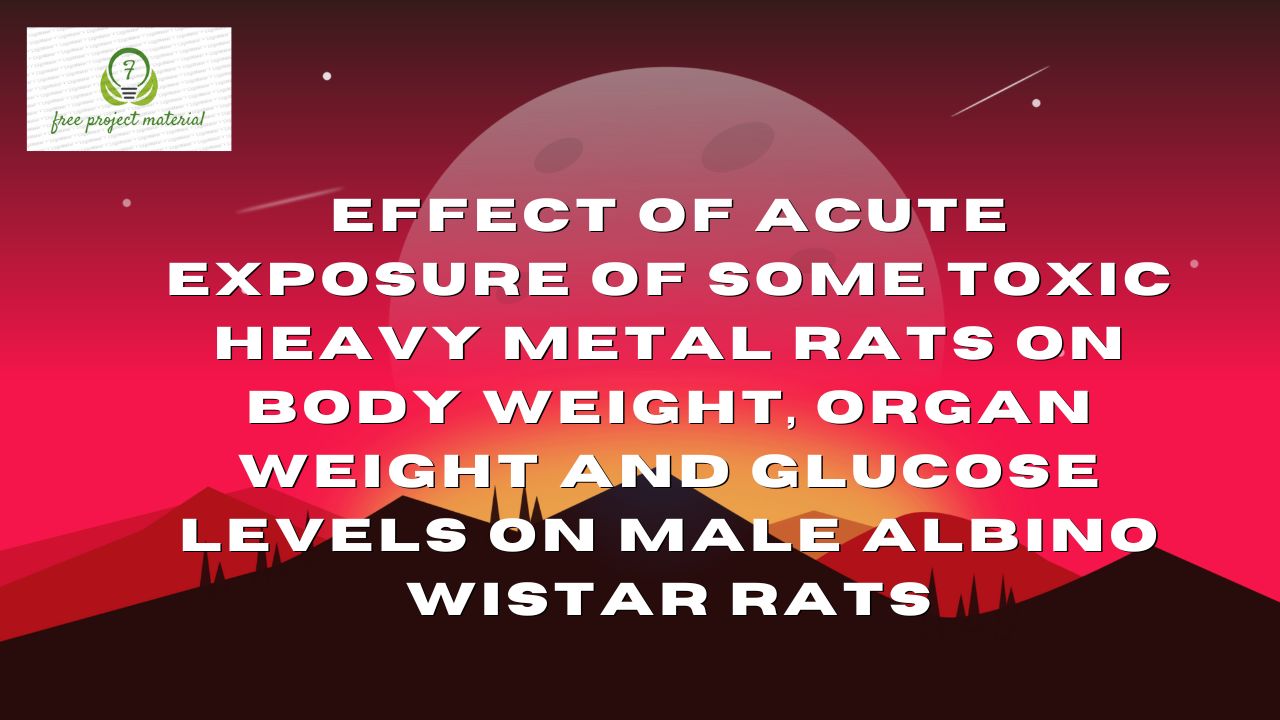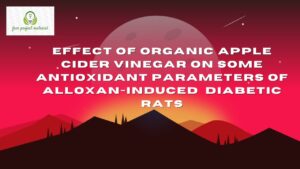ABSTRACT
The effect of some heavy metal salts on body weight, organs weight and glucose level of male albino wistar rats was investigated. Thirty (30) male albino wistar rats with weight range of 127.0-218. 8g were randomly assigned six (6) groups with each group having five (5) animals. Group 1 served as the control and was given distilled waters and animals feed for seven days. Rats in group 2 were administered with 1ml of 0.033mg/kg body weight of lead acetate solution for seven days. Group 3 rats were treated with 1ml of 0.015mg/kg body weight of cadmium chloride solution daily for seven days, group 4 received 1ml of 0.206mg/kg body weight of chromium sulphide solution for seven days, group 5 received 1m of 0.010mg/kg arsenic trioxide, whole rats in group 6 received 1ml of 0.001mg/kg for seven days. All the experimental animals were allowed free access to standard rat pellet diet and distilled water ad libitum. The result obtained from the analysis showed a non-significant decrease (p>0.05) in the body weight in group 2, 4 5 and 6, whereas there was a non-significant increase (p>0.005) in group 3 when compared to the control group. There was a non-significant decrease (p> 0.05) in the liver in all the groups when compared to the control. The weight of the kidney showed a non-significant decrease (p>0.05) in all the groups when compared to the control except for group 3 which showed a non-significant increase (p>0.05). There was a non-significant decrease (p> 0.05) in the brain weight in all the groups except for group 3 that showed a non- significant effect when compared to the control. The weight of the heart showed a non-significant increase (p>0.05) in group 2 and 3 whereas there was a non-significant decrease (p>0.05) in group 4, 5 and 6 when compared to the control. The weight of the pancrease showed a non-significant increase (p>0.05) in group 2 and 5 while a non-significant decrease (p>0.05) in group 3, 4 and 6 when compared to the control. The weight of the lungs revealed a non-significant decrease (p>0.05) in group 2, 3,4 and 5 whereas there was a significant decrease (p<0.05) in group 6. The result of glucose level showed a significant decrease (p<0.05) in group 3 while there was a non-significant decrease (p>0.05) in group 2,4, 5 and 6 when compared to the control.
TABLE OF CONTENTS
Title page- – – – – – – – – – i
Certification- – – – – – – – – ii
Dedication- – – – – – – – – – iii
Abstract.- – – – – – – – – – iv
TABLE OF CONTENTS
CHAPTER ONE
INTRODUCTION
1.1 Background of the study- – – – – – – – 1
1.2 Aim and objectives of the study- – – – – – – 3
1.2.1 Aims- – – – – – – – – – – 3
1.2.2 Objectives- – – – – – – – – – 3
1.3 Scope and limitation of the study- – – – – – – 3
1.4 Definition of terms- – – – – – – – – 4
CHAPTER TWO
LITERATURE REVIEW
2.1 Heavy Metals- – – – – – – – – – 5
2.2 Sources of heavy metals- – – – – – – – 6
2.3 Essential and non- Essential heavy metals- – – – – 8
2.4 Human exposure of heavy metals – – – – – – 9
2.5 Health effects of heavy metals – – – – – – – 11
2.6 Biochemical importance of heavy metals – – – – – 14
2.7 Types of heavy metal and its mechanism of heavy metal toxicity – – 16
2.8 Effect of heavy metal on organ weight, body weight and glucose level – –
CHAPTER THREE
MATERIALS AND METHODS
3.1 Materials and Reagents- – – – – – – – 34
3.1.1 Procurement of heavy metals – – – – – – – 35
3.1.2 Preparation of heavy metals- – – – – – – 35
3.1.3 Experimental Design and treatment- – – – – – 36
3.2 METHODS- – – – – – – – – – 37
3.2.1 Estimation of Fasting Blood Glucose- – – – – – 37
3.2.2 Determination of Organ Weight of the rat- – – – – 38
3.2.3 Determination of Body Weight- – – – – – – 38
3.2.4 Statistical Analysis – – – – – – – – 38
CHAPTER FOUR
RESULTS AND DISCUSSION
Table 4.1 – – – – – – – – – – 39
Table 4.2 – – – – – – – – – – 40
Table 4.3 – – – – – – – – – – 41
4.1 Results- – – – – – – – – – – 42
4.2 Discussion- – – – – – – – – – 43
CHAPTER FIVE
CONCLUSION AND RECOMMENDATION
5.1 Conclusion- – – – – – – – – – 47
5.2 Recommendation- – – – – – – – – 47
References
CHAPTER ONE
INTRODUCTION
1.1 Background of the study
Introduction of persistent toxic substance and heavy metals into environment is a major worldwide environmental issue. These substances are characterized by their longevity, thereby exerting high chronic toxicity. Among heavy metals lead and cadmium exposures have allured the circumspection of toxicologist and environmentalists, because of health problems associated with these metals. Both heavy metals are common
source of contamination and are ubiquitous in the environment (Mazumder,
2008).
Heavy metals are generally referred to as those metals which posses a specific density of more than 5g/cm3 and adversely affects on the environment and living organisms (Jarup, 2003).these metals are quintessential to maintain various biochemical and physiological functions in living organisms when in very low concentration, however they become noxious when they exceed certain threshold concentration. Although, it is acknowledge that heavy metals have many adverse health effects and last for a long period of time, heavy metals exposure continues and is increasing in many parts of the world.
Heavy metals are significant environment pollutants and their toxicity is a problem of increasing significance for ecological, evolutionary, nutritional and environmental reasons (Jaishankar et al…, 2013). The most commonly found heavy metals in waste water include arsenic, cadmium, chromium, copper, lead, nickel and zinc, all of which cause risk for human health and the environment (lambert et al …, 2000).
Heavy metals enter the surroundings by natural means and through human activities. Various source of heavy metals includes: soil erosion, natural weathering of the earth’s crust, mining, industrial effluents, urban runoff, sewage discharge, insect or disease control agents applied to crops and many others (Morais et al …,2012)
Although these metals have crucial biological functions in plants and animals, sometimes their chemical coordination and oxidation reduction properties have given them an additional benefit so that they can escape control mechanisms such as homeostasis, transport, compartmentalized and binding to required cell constituents. These metals bind with protein sites which are not made for them by displacing original metals from their natural binding sites causing malfunctioning of cells and ultimately toxicity. Previous research has found that oxidative deterioration of biological macromolecules is primarily due to binding of heavy metals to the DNA and nuclear proteins (flora et al …,2008)
Heavy metals are among the contaminants in the environment. Besides the natural activities almost all human activities also have potential contribution to produce heavy metals as side effects migration of those contaminants into non contaminated areas as dust or leachates through the soil and spreading of heavy metals containing sewage sludge are few examples of events contributing towards contamination of the ecosystems (Gaur and Adholeya, 2004)
1.2 AIM AND OBJECTIVES OF THE STUDY
1.2.1 Aims:
The aim of this research work is to determine the effect of heavy metals on body weight, organ weight and glucose.
1.2.2 Objectives:
- i) To determine heavy metal effect on body weight
- ii) To determine heavy metal effect on some organ weight (liver, kidneys, brain, heart, pancreases, lungs)
- To determine heavy metal effect on glucose
1.3 SCOPE AND LIMITATIONS OF THE STUDY
This research work is limited to the determination of effect of heavy metal on body weight, organ weight and glucose due to lack of adequate materials, time and financial constraints.
1.4 DEFINITION OF TERMS
Heavy Metals: refers to any metallic chemical element that has a relatively high density and is toxic or poisonous at low concentrations. Examples of heavy metals includes, Mercury (Hg), cadmium (Cd), arsenic (As), chromium (Cr), thalium (Ti) and lead (pb)
Body weight: is the measurement of weight without items located on the person. Practically though, body weight may be measured with clothes on, but without shoes or heavy accessories such as mobile phones and wallets, and using manual or digital weighting scales. Excess or reduced.
Organ weight: an organ is a self-contained group of tissues that performs a specific function in the body. Example includes; heart, liver and stomach.
Glucose: is a simple sugar with the molecular formula C6 H2 O6.
Glucose is the most abundant monosaccharide, it is mainly made by plants and most algae during photosynthesis from water and carbon dioxides, using energy from sunlight, where it is used to make cellulose in cell walls, which is the most abundant carbohydrate. (Ramirez, 2013)



